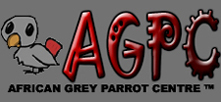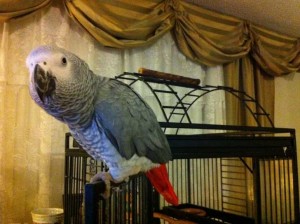There is a mass abundance of information out there about parrot cages, their shapes, size’s, colours and styles, I thought I would put this article together to offer a few hints and tips and the basic’s I have learnt over the years to help you to decide which cage is best suited to you, your parrot and your home.
1. Size Counts
Firstly the most important factor is the size of the cage the best rule to go by is the bigger the better, and where you are planning on keeping your parrot to ensure you have enough space for it. The cage needs to be big enough for your parrot to be able to freely spread it’s wings have a flap about for exercise, on the other hand if the cage is too big it could cause a problem to smaller parrots, for instance if you had a cage big enough to house a macaw the bar spacing will be far too big for a smaller parrot such as a Timneh Grey meaning there’s a high possibility its feet and head are caught and panic could cause untold damage, any good pet shop that sells cages can help you with information on the size of the cage you should be buying to suit your parrot.
2. Maintenance
Also to consider when buying a cage is it easy to keep clean and maintain. The best type to look for are the ones with a pull out tray to make cleaning the bottom of the cage a lot easier. Also another great feature which make life a lot easier are food and water bowls that are replaced without opening the main door of the cage with the possibility of letting your parrot out, they are cheeky things and often take advantage of an open door, this type of water bowls have their own small doors and as I say really is a neat feature.
3. Positioning your Cage
The cage should be kept in a position where your parrot will feel safe which is away from drafts such as windows which can make your parrot too hot if left in direct sunlight, another really important factor to think about is if you put your parrot cage in front of the window you could be leaving yourself wide open to being broken into and having your beloved parrot stolen which unfortunately really does happen a lot. Your parrot is worth lots of money and thieves often target parrots these days and would rather steal your parrot than a big heavy appliance like a TV, you may think that it would be hard to steal a parrot but once covered over with something a parrot becomes quiet and still.
Also consider placing your parrot cage somewhere that you and your family will pass and visit a fair number of times a day, parrots are social animals and love to be part of the action and have contact with you and the family so the living room would make a great place, ideally your cage should be placed in a corner of the room that is well lit so your parrot has some security of knowing that it can’t be approached from the back of it’s cage and/or one side which gives it the feeling of safety.
4. Toys & Amusements
You need to think about what toys you are going to put inside the cage for your parrot’s amusement, African greys love playing with toys and can amuse themselves with toys for a long time, simple things like a rope can keep them happy for many hours or something as simple as a wooden toy that they can chew with a bell which rattles when moved (Make sure it’s not so noisy that it irritates you). There are so many toys out there you just need to make sure that they are safe and can’t get caught round you birds neck or have tiny bits that can be swallowed (just like a small child), check any toy you buy carefully and if your not 100% sure it is safe DON’T buy it. Once you have some toys you can always rotate them around in the cage to keep them amused and as soon as one becomes too damaged such as a rope being shredded into bits remove it, our African grey Reggie must have been shredding his rope toy when we were out as when we came home he had it all tied round his feet and was sat on the bottom of his cage, for this reason we now remove any toys that get a little tatty.
5. Perches
You really need to consider the type of perches you use in your cage, the perches that usually come with a cage as standar are not really ideal and should be replaced with something more appropriate as soon as possible, something like java branches or branches from fruit trees such as pear, apple, hazelnut or even willow tress can all be used as long as you wash them down first and let them dry before placing the in the cage. This will provide your parrot with different thickness of perches, I also highly recommend a placing a concrete perch in the cage near the food or water bowls to ensure your parrot uses them, this will help to keep your parrots nails trim and beak under control as they like to rub it on the perch, I use more than one in the cage near the bowls as I mentioned, you can even get them in different colours and sizes, these are sold at most pet shops and each pack should have what size bird it is most suited too, just use your intuition to work out what size is best.
If your planning on letting your parrot out of the cage a lot (which you should!) you can consider buying your parrot a play gym, there are many good play gyms out there on the market, the one we use is the Java parrot tower which is great as it is on castors and has a big tray that catches all the dropped food and droppings, best of all the java branches can all be taken off to be cleaned, also you can move them about and add rope and sandy perches to help keep the parrots nails down. Our African grey Reggie sometimes stay out for days on end, he is very good and will just sit and play on his parrot tower, have a fly about from time to time but always returns back to his tower, he hates being in his cage though I would not recommend leaving your African grey out when you’re not around unless your 100% sure it will not get into trouble or fly down and chew things (Read the home hazards for Greys article), I am home all day long so am never far away in such cases, if we go out at all and no one is at home then we put him away. Reggie has been trained over the 12 years we have had him and even now sometimes gets over excited and flies down when he wants some extra attention!
Cage Hints and Tips Summary
- Get the biggest but most appropriate cage for your parrot that you can fit into your home
- Choose a cage that is easy to maintain, check the bowls can be changed in their own doors and their are pull out trays, make sure you clean your cage regularly
- Position your cage in a safe position away from drafts, hot/cold areas and always ensure it’s not on show to the outside world in case of theft
- Always fill your cage with toys to keep your parrot amused but always ensure they are in good condition to keep your parrot safe
- Dump those standard perches, replace with Java or safe tree branches and concrete perches near their bowls for ongoing nail/beak maintenance
About the Author
Written by Paula Dansie of the African Grey Parrot Centre ™
This article may be duplicated in its full state but the above link must be retained, if this article is found duplicated anywhere on the web without the link preserved then legal action will be taken and your ISP will be contacted.



Great article, very useful for first time grey owners. Our grey comes on our narrow boat with us. He travels in the car singing all the way! We have another cage on the boat which is very much smaller but enough room for him to stretch and climb around. We let him out as much as possible.
Good info re perches. I’m always concerned re what type of wood. I bought a bundle of willow long sticks intended for walking sticks from eBay. Fabulous for new perches!
Thanks for your comment on our blog post and glad you found it really useful,I bet your Grey loves going on your narrow boat with you!
I love your tip about the Willow sticks intended for walking sticks from ebay great idea thanks for sharing!
Best wishes
Paula
hya im baby grey in few week and if i most say this was so helpfull thanks fo the blog theres 1 q i want to ask u if ya dont mind wat dose the gap want to be in my cage bars
Hi Thomas
The cage spacing for a African Grey should be no smaller that 3/4 of a inch, normally most cages have a spacing of 1″
Hope that helps
Paula